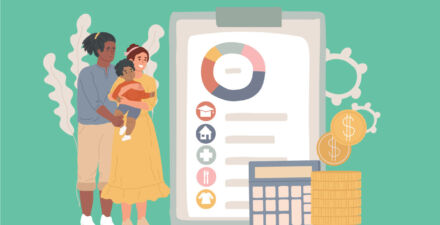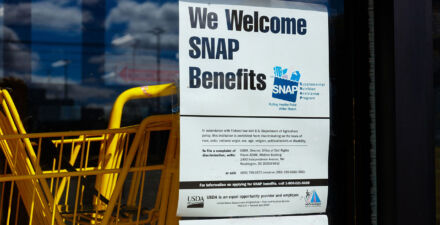Improving economic outcomes for single mothers and their children across the United States

Single-mother households are becoming more and more common in the United States. Over the past 50 years, the number of children raised by single mothers has more than doubled. It is the second-most common living arrangement for children in the United States; living with co-habitating parents is the only more common arrangement. More children in the United States are raised by single parents, the majority of whom are single mothers, than in any other country in the world.
Single mothers and their children across the United States face particularly challenging economic circumstances. For instance, it is well-documented that single mothers, compared to mothers in co-habitating living arrangements, are at a greater risk of living in poverty. According to the most recent U.S. Census Bureau’s Supplemental Poverty Measure, almost a quarter of single-female-headed households live in poverty, at 23.9 percent.
U.S. economic policies have not evolved to adequately serve single mothers. As a whole, social infrastructure policies in the United States may only modestly ameliorate the risk of poverty for single mothers and their children because targeted income support programs tend to be insufficient for lifting families out of poverty.
The U.S. Congress and the second Trump administration can help support single moms and their children. Three factsheets and an overarching column, authored by the Washington Center for Equitable Growth and published by Share Our Strength’s Center for Best Practices, explain in detail why these young families in particular need support. But briefly, these analyses present the evidence that government income support programs such as the Supplemental Nutrition Assistance Program, the Child Tax Credit, and Unemployment Insurance, as well as Medicaid, not only help young families, especially those led by single mothers, but also boost stronger long-term U.S. economic growth. These factsheets and column also detail policy recommendations, many of which enjoy bipartisan support in Congress.
Yet already-divisive congressional debates over tax and budget policies in 2025 signal strong efforts to gut these programs in favor of tax cuts for the wealthy and corporations. The tax cuts enacted during the first Trump administration greatly benefited these two privileged constituencies and are set to expire in September. To maintain those tax breaks, Republican members of Congress and the new Trump administration are eying massive cuts to the bedrock social infrastructure that provide income support to single-mother households, young families in general, and underpin broad-based U.S. economic growth and long-term prosperity.
To learn more about economic status of single mothers and the policies available to support improved economic outcomes for single mothers and their children, you can read the column “Three policies to improve economic outcomes for single mothers and their children across the Unites States.” Recently enacted policies that were briefly implemented in the United States have successfully reduced poverty for single mothers—most notably, the temporary expansion of the Child Tax Credit amid the COVID-19 pandemic.
While the success of this tax credit points to a way forward for policymakers, strong evidence suggests there are other policies available to ensure robust economic security and thus more equitable economic growth. These include, but are not limited to, eliminating work requirements for income supports, streamlining access to income supports, and improving child care infrastructure.
Evidence-based research also shows that implementing work requirements does not encourage a desire not to work but rather discourages participation in income support programs, including the Temporary Assistance for Needy Families program, the Supplemental Nutrition Assistance Program, and Medicaid. To learn more, read “Factsheet: Eliminating work requirements can support single mothers and foster equitable U.S. economic growth.”
Indeed, income support programs, such as Unemployment Insurance and Temporary Assistance for Needy Families, fulfill multiple key roles in the functioning of a strong economy. During economic downturns, income supports automatically stabilize the U.S. macroeconomy by maintaining spending and consumption levels despite higher rates of unemployment.
Single-mother households, in particular, also are at a comparatively greater risk of being in poverty and have lower wealth than any other group of U.S. households. Income supports help these households cover basic life expenses, which research demonstrates can have long-term benefits for promoting intergenerational economic mobility and reducing economic inequality. To learn more, read “Factsheet: Streamlining income supports can help single mothers and foster equitable U.S. economic growth.”
Many families in the United States do not have a robust network of support when it comes to raising children. Approximately half of families in the United States, for instance, live in so-called child care deserts, or U.S. Census Bureau tracts with more than three children under age 5 for every one licensed child care slot. Recent survey research suggests that finding child care is a significant barrier to accessing child care, with 79 percent of single-parent families reporting difficulty finding care. When families can find care, it is often unaffordable, especially for single-mother households. To learn more, read “Factsheet: Improving child care infrastructure supports single mothers and promotes equitable growth in the United States.”
Despite this weight of evidence, it’s unclear whether the second Trump administration and Republican majorities in the 119th U.S. Congress will pursue any policies to alleviate the child care burden faced by families, despite several bipartisan efforts to do so now before Congress. It is clear, however, that they intend to pursue increased implementation of work requirements to reduce federal spending and access to income support programs that low-income families, and especially single-mother households, rely on in order to provide tax cuts for the wealthiest Americans and corporations.
Tax cuts are neither a path to stronger economic growth nor a way to help young parents and the next generation of Americans they are raising prepare for the second half of the 21st century. Rather, pro-growth tax reform in 2025 would boost the U.S. economy and support young families for years to come.
Did you find this content informative and engaging?
Get updates and stay in tune with U.S. economic inequality and growth!






